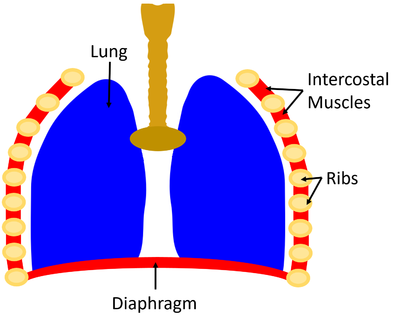Difference between revisions of "Breathing"
| Line 14: | Line 14: | ||
| style="height:20px; width:400px; text-align:left;" | | | style="height:20px; width:400px; text-align:left;" | | ||
To [[inhale]] the [[diaphragm]] [[contract]]s and goes down while the [[Intercostal Muscle|intercostal muscles]] [[contract]] pulling the [[Rig Cage|ribs]] upwards and outwards. | To [[inhale]] the [[diaphragm]] [[contract]]s and goes down while the [[Intercostal Muscle|intercostal muscles]] [[contract]] pulling the [[Rig Cage|ribs]] upwards and outwards. | ||
| + | |||
To [[exhale]] the [[diaphragm]] relaxes and goes up while the [[Intercostal Muscle|intercostal muscles]] relax allowing the [[Rig Cage|ribs]] to go down and inward. | To [[exhale]] the [[diaphragm]] relaxes and goes up while the [[Intercostal Muscle|intercostal muscles]] relax allowing the [[Rig Cage|ribs]] to go down and inward. | ||
|} | |} | ||
Revision as of 16:29, 17 September 2018
Key Stage 3
Meaning
Breathing is the process of inhaling Oxygen and exhaling Carbon Dioxide.
About Breathing
- To breath the lungs must be able to take in new air and release the old air.
- When the lungs take in air this is called inhalation.
- When the lungs get rid of old air this is called exhalation.
|
To inhale the diaphragm contracts and goes down while the intercostal muscles contract pulling the ribs upwards and outwards. To exhale the diaphragm relaxes and goes up while the intercostal muscles relax allowing the ribs to go down and inward. |
| An animation of the lungs inhaling and exhaling. |

